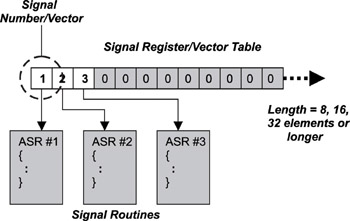Книга: Real-Time Concepts for Embedded Systems
8.4.2 Typical Signal Operations
8.4.2 Typical Signal Operations
Signal operations are available, as shown in Table 8.6.
Table 8.6: Signal operations.
| Operation | Description |
|---|---|
| Catch | Installs a signal handler |
| Release | Removes a previously installed handler |
| Send | Sends a signal to another task |
| Ignore | Prevents a signal from being delivered |
| Block | Blocks a set of signal from being delivered |
| Unblock | Unblocks the signals so they can be delivered |
A task can catch a signal after the task has specified a handler (ASR) for the signal. The catch operation installs a handler for a particular signal. The kernel interrupts the task’s execution upon the arrival of the signal, and the handler is invoked. The task can install the kernel-supplied default handler, the default actions, for any signal. The task-installed handler has the options of either processing the signal and returning control to the kernel or processing the signal and passing control to the default handler for additional processing. Handling signals is similar to handling hardware interrupts, and the nature of the ASR is similar to that of the interrupt service routine.
After a handler has been installed for a particular signal, the handler is invoked if the same type of signal is received by any task, not just the one that installed it. In addition, any task can change the handler installed for a particular signal. Therefore, it is good practice for a task to save the previously installed handler before installing its own and then to restore that handler after it finishes catching the handler’s corresponding signal.
Figure 8.12 shows the signal vector table, which the kernel maintains. Each element in the vector table is a pointer or offset to an ASR. For signals that don’t have handlers assigned, the corresponding elements in the vector table are NULL. The example shows the table after three catch operations have been performed. Each catch operation installs one ASR, by writing a pointer or offset to the ASR into an element of the vector table.

Figure 8.12: The catch operation.
The release operation de-installs a signal handler. It is good practice for a task to restore the previously installed signal handler after calling release.
The send operation allows one task to send a signal to another task. Signals are usually associated with hardware events that occur during execution of a task, such as generation of an unaligned memory address or a floating-point exception. Such signals are generated automatically when their corresponding events occur. The send operation, by contrast, enables a task to explicitly generate a signal.
The ignore operation allows a task to instruct the kernel that a particular set of signals should never be delivered to that task. Some signals, however, cannot be ignored; when these signals are generated, the kernel calls the default handler.
The block operation does not cause signals to be ignored but temporarily prevents them from being delivered to a task. The block operation protects critical sections of code from interruption. Another reason to block a signal is to prevent conflict when the signal handler is already executing and is in the midst of processing the same signal. A signal remains pending while it’s blocked.
The unblock operation allows a previously blocked signal to pass. The signal is delivered immediately if it is already pending.
- 8.5.2 Typical Condition Variable Operations
- 8.4.3 Typical Uses of Signals
- 8.5.3 Typical Uses of Condition Variables
- LOCK SIGNAL
- 11.7 Soft Timers and Timer Related Operations
- 2.2.1. Typical Embedded Linux Setup
- 7.3.3. Network Operations
- 8.3.1. Driver File System Operations
- 7.2.3. Standard Operations
- 9.4.3. Communication Operations
- Typically Used sendmail.mc Parameters
- 5.4 Typical Task Operations




